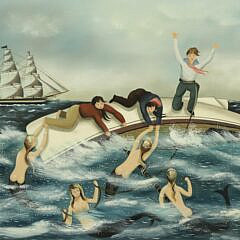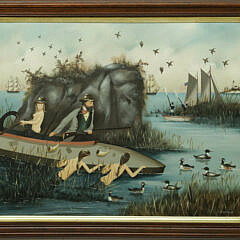Ralph Cahoon (1910-1982)
Descended from 17th century Scottish immigrants to Cape Cod, Ralph Eugene Cahoon, Jr. was essentially a self-taught folk artist. His only formal training consisted of a two-year course at the School of Practical Art in Boston. In 1932, Ralph met and married Martha Farham, the daughter of Swedish immigrants. Martha’s father, Axel, was a talented furniture decorator who had learned the art of painting furniture (rosemaling) in Sweden. He taught this craft to Martha, who in turn taught Ralph.
Upon marrying, the couple set up home in Osterville where they established a business decorating and selling furniture and antiques. In 1945 they moved their family and business to Cotuit, purchasing the 1775 Crocker building for that purpose.
Around 1953, one of the Cahoon’s customers, art patroness Joan Whitney Payson, convinced them to frame some of their designs for her to exhibit in her Long Island Country Art Gallery. The transition from furniture to easel painting was a successful one and the years that followed were very productive. During the 1960s, Ralph’s hallmark mermaids helped to establish his own unique style; in paintings set in a typical New England backdrop: ocean, lighthouses, clipper ships, and perhaps a hot air balloon or two in the sky.
Throughout the 1960s and 1970s Cahoon’s folk art regularly sold out exhibitions at the Lobster Pot Gallery on Nantucket and Palm Beach Galleries in Florida. Famous people who visited the Cotuit gallery included members of the Mellon and DuPont families, Josiah K. Lilly III, as well as First Lady Jacqueline Kennedy.
Today Ralph Cahoon is widely regarded as the most famous folk artist Cape Cod has produced. His work is highly collectable.
Excerpted from the Cahoon Museum of American Art, Cotuit, MA
Recent Examples at Auction










- Joan Albaugh
- Ethel Anderson
- William D. Appleton
- Clifford Warren Ashley
- John Austin
- Milton Avery
- Solon Francis Montecello Badger
- James Francis Barker
- Doris & Richard Beer
- Eugene Louis Boudin
- Alfred Thompson Bricher
- Albert Bross
- Robert Bushong
- Polly Bushong
- James Edward Buttersworth
- Ralph Eugene Cahoon
- Martha Cahoon
- Nikita Carpenko
- Lincoln J. Ceely
- Frederick S Chadwick
- Rodney Charman
- Frank Swift Chase
- Leander M Churbuck
- Elizabeth Rebecca Coffin
- Anne Ramsdell Congdon
- Colin Campbell Cooper
- Laura Cooper
- Mellie Cooper
- Frank Corso
- James Cromartie
- Roy Cross
- Vu Cao Dam
- William R. Davis
- Gene Davis
- Molly Dee
- Donald Demers
- John Devaney
- William Duffy
- Lawrence Charmichael Earle
- Henry Stephens Eddy
- Alan J. Eddy
- Virginia Bargar Evans
- José Fabri-Canti
- John Falato
- George Gardner Fish
- Annie Barker Folger
- James Walter Folger
- Stephen Gibbs
- André Gisson
- Sybil Goldsmith
- Emile Albert Gruppe
- Marilyn Guerinot
- Mauritz Frederik Hendrick de Haas
- Davis Hall
- Kerry Hallam
- James Harrington
- James Hathaway
- Lowell Herrero
- Jason Emerson Herron
- Philip Hicken
- George Frank Higgins
- G.S. Hill
- Megan Hinton
- Emily Hoffmeier
- Alfred Heber Hutty
- George Inness
- Antonio Nicolo Gasparo Jacobson
- Edgar W. Jenney
- Theodore Jeremenko
- Eastman Johnson
- Illya Kagan
- Michael Keane
- William Keith
- David Kooharian
- Kenneth Layman
- David Lazarus
- George Lear
- Richard Hayley Lever
- John Lochtefeld
- Harriet Lord
- Richard Loud
- William W. Lowe
- Michael Lynch
- William Starbuck Macy
- William Ferdinand Macy
- Wendell Macy
- Aletha Macy
- George Herbert McCord
- Keith McDaniel
- Joseph McGurl
- Maggie Meredith
- Addison Thomas Millar
- Jan L. Munro
- Mary Sarg Murphy
- Mark Myers
- Tom Nicholas
- Reginald Eugene Nickerson
- Michael A. Palmer
- Margaret Jordan Patterson
- Jan Pawlowski
- Edgar Payne
- C. Robert Perrin
- Helen Sharp Potter
- Jane Brewster Reid
- José Formoso Reyes
- Volney Allan Richardson
- Forrest Anderson Rodts
- Sergio Roffo
- Lenka Rubenstein
- Elizabeth Saltonstall
- Andrew Jackson Sandsbury
- Tony Sarg
- Issac Sheffield
- Andrew Shunney
- Henry Pember Smith
- Lillian Gertrude Smith
- H. Stadler
- Richard Stalter
- Robert Stark Jr.
- William Pierce Stubbs
- Mara Superior
- Ruth Haviland Sutton
- Ferdinand Sylvaro
- Anthony Thieme
- Tim Thompson
- Roy Tidmarsh
- Yasemin Tomakan
- Katie Trinkle-Legge
- Isabelle Hollister Tuttle
- Emma H. Van Pelt
- William Welch
- Orrin Augustine White
- Paul Whitten
- Paul Willer
- Sid Willis
- Bert Wright
- James Wyer
- Julian E. Yates
- Lori Zummo

![cahoon[1]](https://dn9ml16rd2hb8.cloudfront.net/2014/04/JrTJqBXj-cahoon1-304x405.jpg)